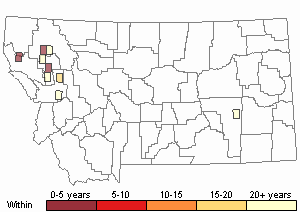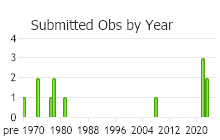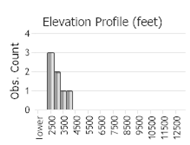View in other NatureServe Network Field Guides
NatureServe
Montana
Utah
Wyoming
Idaho
Wisconsin
British Columbia
South Carolina
Yukon
California
New York
Purple-fringed Riccia - Ricciocarpos natans
General Description
Plants thallose, simple, with few advancements (rhizoids and spores) beyond algae (Bland 1971). Thallus 4-10 mm in length and 4-9 mm in across (Doyle 2006), brilliant green, composed of shallowly-forked heart-shaped lobes marked with a purple central line, forming rosettes, free-floating on water (Nicholson 1966, Schofield 2002). Air chambers on dorsal surface form hexagonal pattern perceptible to unaided eye; a pore in the center of each may appear as a dot (hand lens helpful). Numerous long, violet-colored scales, spread throughout on the ventral surface, protrude downward and provide equilibrium in the water (Nicholson 1966, Schofield 1985, 2002). Plants marooned on soil are greyish to yellow-green, possess a central groove on upper surface, and maintain violet or hyaline scales below (often hidden among the abundant rhizoids) (Doyle 2006).
Diagnostic Characteristics
Riccia cavernosa, which may also be found on soil at the water’s edge, resembles the terrestrial form of Ricciocarpos natans in size. However, the former’s thallus is a very light green. The thallus of R. natans is a dark green and has a purple line bisecting the lobes (Schofield 2002).
Observations in Montana Natural Heritage Program Database
Number of Observations: 15
(Click on the following maps and charts to see full sized version)
Map Help and Descriptions
Relative Density

Recency



 (Observations spanning multiple months or years are excluded from time charts)
(Observations spanning multiple months or years are excluded from time charts)
Habitat
Quiet or sheltered and slow-moving waters such as ponds, ditches, backwaters, and lake coves (Nicholson 1966, Schofield 2002), often among aquatic vascular plants (e.g. Azolla, Lemna, Wolffia) where R. natans is difficult to notice (Doyle 2006). Following its deposition with the retreat of water, R. natans is adapted to grow on muddy shores (Schofield 2002).
Reproductive Characteristics
Broken-off thallus lobe pieces that embed sporangia may provide primary means of reproduction following decomposition of the thallus. Sporophytes seldom produced (Schofield 2002).
Management
Grows well in waters polluted with organic compounds. Large groups of these plants may drift on the water’s surface (Schofield 1985).
References
- Literature Cited AboveLegend:
 View Online Publication
View Online Publication Bland, J.H. 1971. Forests of Lilliput: The Realm of Mosses and Lichens. Englewood Cliffs, NJ: Prentice-Hall. 210 p.
Bland, J.H. 1971. Forests of Lilliput: The Realm of Mosses and Lichens. Englewood Cliffs, NJ: Prentice-Hall. 210 p. Doyle, W.T. and R.E. Stotler. 2006. Contributions Toward a Bryoflora of California III. Keys and Annotated Species Catalogue for Liverworts and Hornworts. Madroño 53(2): 89-197.
Doyle, W.T. and R.E. Stotler. 2006. Contributions Toward a Bryoflora of California III. Keys and Annotated Species Catalogue for Liverworts and Hornworts. Madroño 53(2): 89-197. Nicholson, B.E. and F.H. Brightman. 1966. The Oxford Book of Flowerless Plants: Ferns, Fungi, Mosses and Liverworts, Lichens, and Seaweeds. London: Oxford University Press. 208 p.
Nicholson, B.E. and F.H. Brightman. 1966. The Oxford Book of Flowerless Plants: Ferns, Fungi, Mosses and Liverworts, Lichens, and Seaweeds. London: Oxford University Press. 208 p. Schofield, W.B. 1985. Introduction to Bryology. Caldwell, NJ: Blackburn Press. 434 p.
Schofield, W.B. 1985. Introduction to Bryology. Caldwell, NJ: Blackburn Press. 434 p. Schofield, W.B., P. Drukker-Brammall, and M. Pacheco. 2002. Field Guide to Liverwort Genera of Pacific North America. Banff, AB: Global Forest Society in association with University of Washington Press. 228 p.
Schofield, W.B., P. Drukker-Brammall, and M. Pacheco. 2002. Field Guide to Liverwort Genera of Pacific North America. Banff, AB: Global Forest Society in association with University of Washington Press. 228 p.
- Additional ReferencesLegend:
 View Online Publication
View Online Publication
Do you know of a citation we're missing? Elliot, J. C. 1993. Second checklist of Montana mosses. Unpublished report. U.S. Forest Service, Region 1. Missoula, MT. 45 pp.
Elliot, J. C. 1993. Second checklist of Montana mosses. Unpublished report. U.S. Forest Service, Region 1. Missoula, MT. 45 pp.
- Web Search Engines for Articles on "Purple-fringed Riccia"





